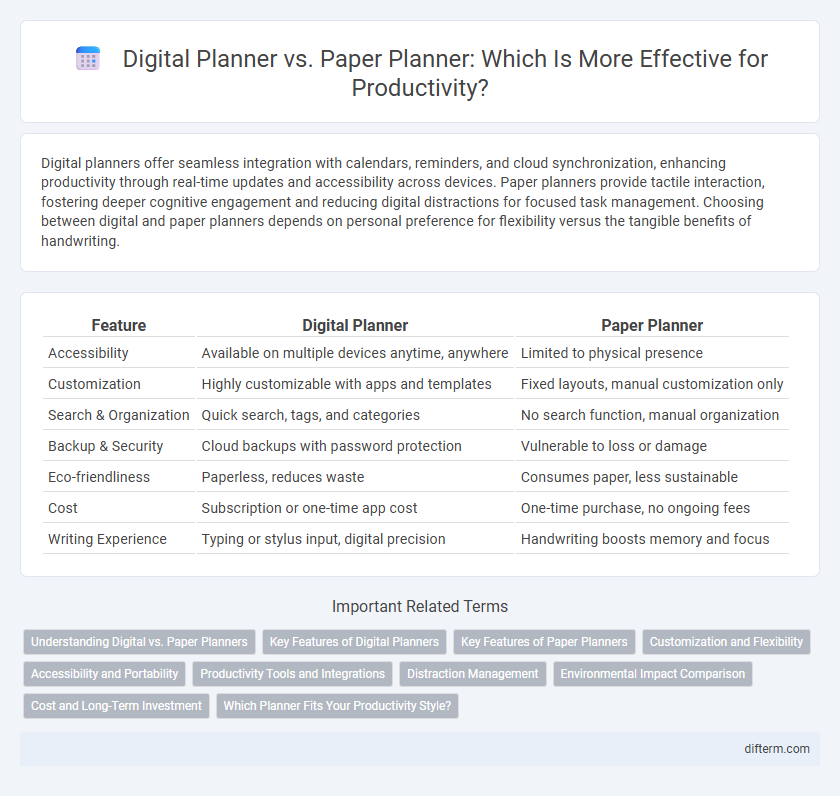Digital planners offer seamless integration with calendars, reminders, and cloud synchronization, enhancing productivity through real-time updates and accessibility across devices. Paper planners provide tactile interaction, fostering deeper cognitive engagement and reducing digital distractions for focused task management. Choosing between digital and paper planners depends on personal preference for flexibility versus the tangible benefits of handwriting.
Table of Comparison
| Feature | Digital Planner | Paper Planner |
|---|---|---|
| Accessibility | Available on multiple devices anytime, anywhere | Limited to physical presence |
| Customization | Highly customizable with apps and templates | Fixed layouts, manual customization only |
| Search & Organization | Quick search, tags, and categories | No search function, manual organization |
| Backup & Security | Cloud backups with password protection | Vulnerable to loss or damage |
| Eco-friendliness | Paperless, reduces waste | Consumes paper, less sustainable |
| Cost | Subscription or one-time app cost | One-time purchase, no ongoing fees |
| Writing Experience | Typing or stylus input, digital precision | Handwriting boosts memory and focus |
Understanding Digital vs. Paper Planners
Digital planners offer features like cloud synchronization, customizable templates, and real-time notifications, enhancing productivity through seamless accessibility across devices. Paper planners provide tactile engagement and cognitive benefits, such as improved memory retention and reduced screen time distractions. Choosing between digital and paper planners depends on individual preferences for flexibility, portability, and the balance between analog focus and digital convenience.
Key Features of Digital Planners
Digital planners offer real-time synchronization across multiple devices, allowing seamless access to schedules and tasks anytime. Advanced features include customizable templates, automated reminders, and integration with apps like email and calendar, enhancing task management efficiency. Cloud storage ensures data security and easy backup, enabling quick recovery and collaboration with team members.
Key Features of Paper Planners
Paper planners offer tactile engagement, allowing users to physically write, which enhances memory retention and focus. They feature customizable layouts, from daily to monthly views, supporting personalized organization and goal tracking without screen distractions. Compact size and offline accessibility make paper planners reliable tools for consistent productivity management.
Customization and Flexibility
Digital planners offer extensive customization through features like templates, color coding, and integration with calendars and apps, enhancing task management efficiency. Paper planners provide tactile flexibility, allowing users to personalize layouts with handwriting, stickers, and creative designs that foster better memory retention. Both tools support productivity by adapting to individual preferences, but digital planners excel in dynamic updates while paper planners promote focused, distraction-free planning.
Accessibility and Portability
Digital planners offer superior accessibility through cloud synchronization, enabling seamless updates and access across multiple devices such as smartphones, tablets, and laptops, which enhances productivity on the go. Paper planners, while limited to physical presence, provide unmatched portability without the need for batteries or internet connectivity, making them reliable in any environment. Both tools serve distinct needs; digital planners excel in dynamic task management, whereas paper planners support tactile engagement and quick reference.
Productivity Tools and Integrations
Digital planners offer seamless integration with productivity tools like calendars, task managers, and cloud storage, enabling real-time updates and synchronized schedules across devices. Paper planners lack direct integration but provide tactile engagement that some users find enhances focus and memory retention. Leveraging digital planner integrations can automate reminders and streamline task management, significantly boosting overall productivity.
Distraction Management
Digital planners offer advanced distraction management tools such as notifications customization, app integration, and focus modes that minimize interruptions, enhancing productivity. Paper planners eliminate digital distractions entirely, allowing users to focus solely on tasks without alerts or screen time temptations. Choosing between digital and paper planners depends on personal preference for either technological features or a distraction-free analog approach.
Environmental Impact Comparison
Digital planners significantly reduce paper consumption, lowering deforestation rates and minimizing landfill waste compared to traditional paper planners. The energy used for device manufacturing and electricity to operate digital planners is offset over time by the elimination of repeated printing and disposal processes. Choosing a digital planner promotes a sustainable lifestyle by reducing carbon footprints and conserving natural resources linked to paper production.
Cost and Long-Term Investment
Digital planners often require an initial investment in a device or subscription but offer long-term savings by reducing the need for physical supplies and enabling easy updates. Paper planners have lower upfront costs but incur recurring expenses from purchasing new planners annually and additional stationery. Choosing a digital planner optimizes productivity expenses over time by combining convenience and cost efficiency, making it a smarter long-term investment.
Which Planner Fits Your Productivity Style?
Digital planners offer customizable features like reminders, syncing across devices, and easy task reorganization, ideal for users who prioritize flexibility and tech integration. Paper planners provide tactile satisfaction, reduced screen time, and increased memory retention, benefiting those who prefer a hands-on, distraction-free approach. Choosing between digital and paper planners depends on whether you value real-time updates and automation or tangible interaction and focus.
digital planner vs paper planner Infographic

 difterm.com
difterm.com